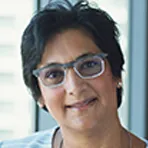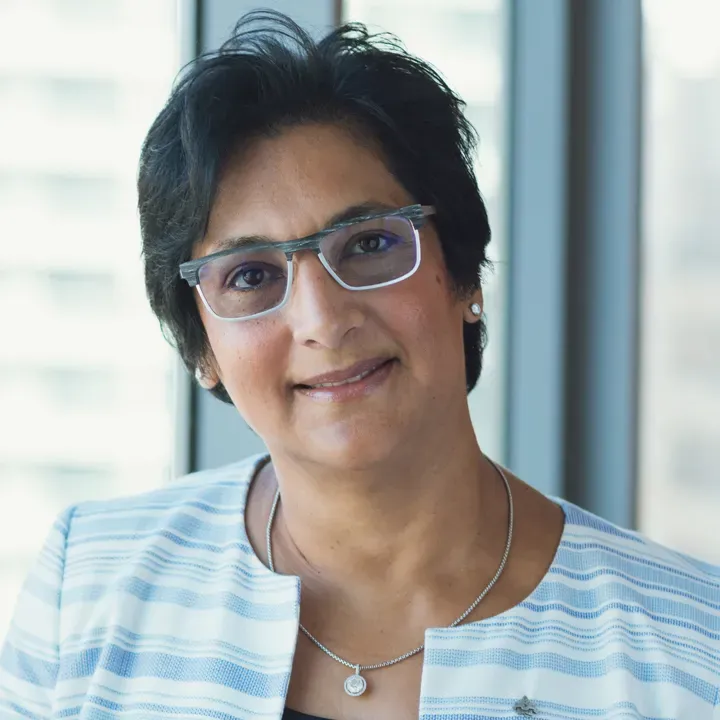When Shainoor Khoja went to Afghanistan in 2003 to serve as the managing director of Roshan Community, the social impact arm of Roshan, a telecom provider founded by the Aga Khan Fund for Economic Development, her assignment was to create a health clinic for the company’s employees. But Khoja soon realized Roshan could have an even greater impact by helping the Afghan population. She expanded the outreach effort to provide nutrition and clothing to street children, built playgrounds and computer labs for young students, and helped persuade Afghan women to work at Roshan.
But her crowning achievement was leveraging Roshan’s internet bandwidth to create a telemedicine system, enabling Afghanistan’s talent-strapped hospitals to train doctors and nurses and tap the expertise of medical experts outside the country.
“I can connect the dots in a way that perhaps not everyone else can,” explained Khojaopen in new window, a 2016 Stanford Executive Program participant. “When I took on this role, basically, the board of directors said, ‘Find one thing the company could get behind.’ But I couldn’t do it that way, because when you think about a marginalized individual or a child, they don’t just need food that’s nutritious, or clothes, or education, or health care. They need it all.”
After leaving Roshan in 2013, Khoja founded Better Business Enterprise, a consulting firm, and has worked in other social ventures, from convincing donors to support education system improvements to her latest venture, Thrive, an online service that supports seniors. It provides everything from home monitoring through Internet of Things technology to an “intergenerational skill swap platform” that will connect them with younger people.
How did being from a displaced family influence you?
I’m of Indian ancestry, but my grandparents moved to Africa. I was born in Dar es Salaam, Tanzania. My father was in the petrol business. Just before my sixth birthday, my father turned up at my boarding school and said, “We need to go pack your bags.” He explained that we were going to move to England, and he put me on a plane. What had happened was that industries and private businesses had been nationalized by the government. My parents had to leave most of their belongings and exit the country. We had two suitcases.
So you basically started over with nothing?
My father had a little money and bought a grocery store with an apartment above it. He was the eldest of three brothers, and each family got a bedroom, with our grandfather in the living room. I was thrown into the family business quite early. I used to label the tins, and in the morning, when the hot bread came, I put it on the shelves. I did the cashier till and made deliveries to the elderly. I learned how to work with different sorts of people. At a young age, I got a sense of the world and that, despite my lot, I was still privileged. There was a national exam where kids who do well can get a scholarship, and fortunately I made the grade to secure a scholarship and attend a private school, where I had the opportunity to get a quality education and play sports and do ballet and take elocution lessons.
Your first career was as a physical therapist. Did that shape your empathy-based approach to business?
In the physio business, I had wealthy executives and sportspeople as patients, and also carpenters and builders who really couldn’t wait six weeks to get better, because they had to get back to work. That was good, because it honed my practice. I learned about the importance of being true to your clients. It’s easy to see people 10, 12, 15 times if you want to. But my target became to get them out the door as soon as I could. You got to know your patients, and you were in a partnership to get them better. It seemed counterintuitive when you’re trying to pay the bills, but it worked.
How did you develop telemedicine in Afghanistan?
At Roshan, as people figured out that I had some money, floods of people came in asking if I would fund this or that, vaccines and MRIs. I visited all the hospitals and realized that they didn’t have qualified people there. I realized that I had to leverage the technology to get it through our board. So I started thinking, “How can we connect people so we can train them?” That coincided with my doing a program at Cambridge where I bumped into a gentleman from Cisco. I told him what I wanted to do, and he said, “Oh, we can fund some of that equipment.” In addition, I had gone as a volunteer to Aga Khan University Hospital [in Pakistan] to teach physiotherapy, and I had strong contacts there. They agreed to be a knowledge partner. We launched in 2007, and since then in excess of 25,000 people have gone through the program.
At Roshan, the business became a vehicle for social change. How did you do that?
We did a lot of work in communities, and built an affiliation on many levels. When we built playgrounds, often the mayors would ask us to build a fence. I would say no, because if I did that then the dominant community would take possession and not let in kids from the other ethnic groups. The idea is that we’re trying to build one Afghanistan. If kids play together, they get to know each other and have nothing to fear. That will lead us to a stronger, more stable Afghanistan, and that’s ultimately good for business.
In what way?
We built a workforce of 1,200 people, of whom 20 percent were women. We’d go into communities and explain what a second salary would mean. We’d pick the women up in the morning, take them home after work. They got health insurance, which I pioneered at Roshan. We intentionally made sure the company had a fair mix of ethnic groups, and to have English as the business language. We wanted to promote a common culture and make sure the women were respected. Today, our deputy CEO is a woman, and she’ll end up being the CEO. We’re very proud of stuff like that.
So then you enrolled in the Stanford Executive Program. What did you take away from that experience?
I needed a program that talks about today’s business models. When I started working on the issue of aging, I realized that we needed something beyond a bricks-and-mortar solution, because that would be too capital intensive and not very scalable. It had to be technology. I also realized that some new things had come along, such as the sharing economy. The group of fellow participants was quite incredible. I got access to individuals with great academic and personal achievement. Now I can phone anywhere in the world and find someone I know whom I can ask about specific countries and sectors. They’re a very tight-knit group. When I think about what I’ve used, some of the case studies come to mind. For example, at Foundation Holdings we’re in the process of investing in a kidney dialysis business. We did a case study about DaVita, a kidney dialysis business that was turned around by a Stanford GSB graduate [Kent Thiry] who became the CEO and learned how he worked with the people there. I use that with my team to say, “This is what we could do.”
Photos by Studio360 Dubai


